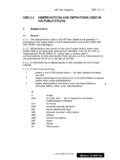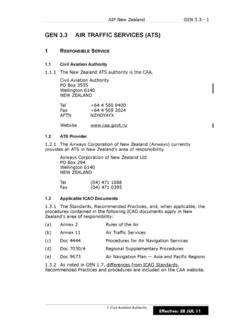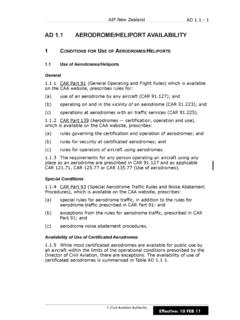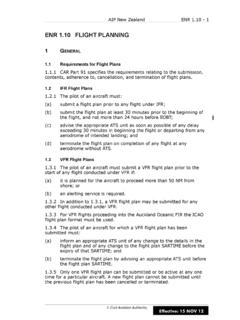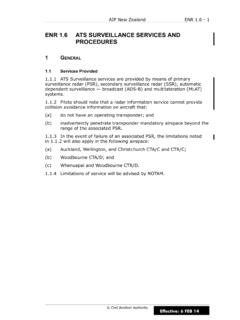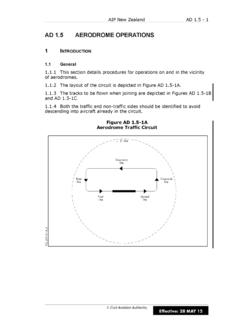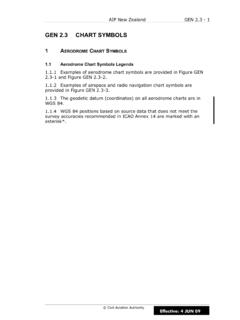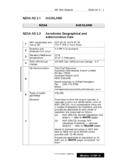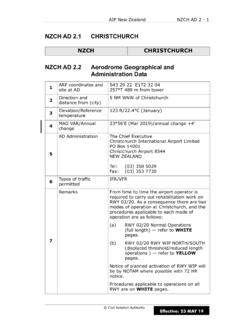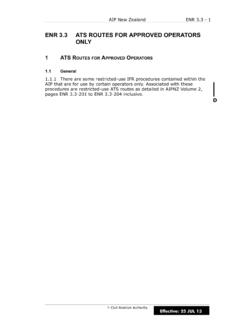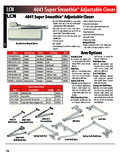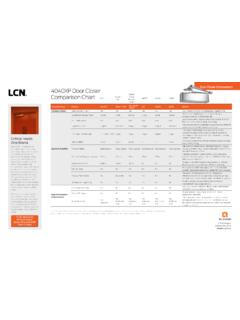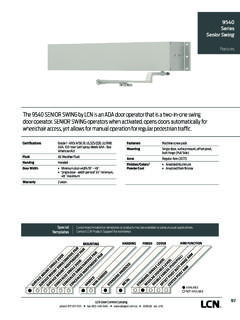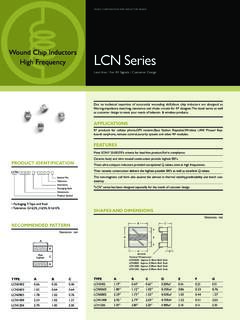Transcription of AD 1.10 OPERATIONAL DATA - AIP New Zealand
1 AD - 1 AIP New ZealandECivil Aviation AuthorityAD OPERATIONAL A summary of OPERATIONAL information is provided in AD 2 for eachaerodrome included in this AIP. The information below explains the The coordinates (in WGS84 datum) for the applicable AerodromeReference Point (ARP) appear at the bottom of each aerodrome or heliportsAD 2 - page. Those annotated with an asterisk * are sourced fromdata that doesn t meet the survey accuracies recommended in ICAO RWY The runway or strip designation is a two-digit number based on thewhole number nearest to one-tenth of the magnetic azimuth of thecentreline when viewed from the direction of approach, if the magneticazimuth of strip is 208 M, the runway will be designated as RWY The surface of the runway or strip is described as one of thefollowing.
2 BBitumenGrGrassCONC ConcreteGr(f)Grass, firmGRVLG ravelGr(s)Grass, The strength of the surface of a grass runway may deteriorate aftermoderate to heavy rain and pilots should therefore exercise great care inthe use of their aircraft brakes in such a situation. Heavy braking can leadto deep scoring of the surface with possible total closure of the An explanation of ESWL, PCN, and LCN is provided below. Where aPCN or LCN is published, the strength of the pavement is acceptable for alllight aircraft with a MCTOW below : 28 JUL 11AD - 2 AIP New ZealandECivil Aviation The majority of New Zealand aerodromes use the equivalent singlewheel load (ESWL) classification of the surface bearing strength of unpavedmanoeuvring areas.
3 Since undercarriage loads in excess of the ESWL valuecould damage the surface, aircraft weights must be limited to ensure thatthe ESWL for the aircraft does not exceed that specified for the For aircraft with a single wheelper undercarriage leg, ESWL is takenas 45% of the all-up weight. For aircraft with multi-wheeled undercarriagelegs the ESWL is lower than this value. Operators should refer to the CivilAviation Authority when an ESWL for this latter type is The pavement classification number (PCN) may be used to specifythe strength of pavements at aerodromes with paved runways. The PCN isestablished by an engineering assessment of the runway. The PCN is anumber expressing the bearing strength of a pavement for unrestrictedoperations, followed by code letters representing:(a) pavement type:(i) rigid pavementR(ii) flexible pavementF(b) sub-grade strength:(i) high strengthA(ii) medium strengthB(iii) low strengthC(iv) ultra-low strengthD(c) maximum allowable tyre pressure:(i) highno pressure limitW(ii) medium1500 kPa maxX(iii) low1000 kPa maxY(iv) very low500 kPa maxZ(d) evaluation method:(i) technical evaluation has been doneT(ii) aircraft experience has provenpavement strength to be The PCN is used in conjunction with an aircraft classification number(ACN).
4 The ACN applies to aircraft types with a MCTOW over 5700 kg whichhave been evaluated. The method of application is detailed in ICAOA nnex : 4 SEP 03AD - 3 AIP New ZealandECivil Aviation The load classification number (LCN) system of pavement evaluationmay be used at certain aerodromes with paved runways, although this isgradually being replaced by the PCN method as assessments are LCN is based on the designed strength of the runway. It relatescertain parameters such as aircraft tyre pressure, number of wheels andgeometry of the undercarriage, and strength and depth of material in thepavement and its foundations, in such a way as to enable a readycomparison between the load imposed by the aircraft and the strength ofthe The LCN of a runway is a fixed value.
5 The LCN figure for a particularaircraft at constant weight, however, varies in relation to the physicalcharacter of the sub-grade and the design of the hard top. The aircraft LCNis a function of the relative stiffness (L) for rigid pavements, and the depthof pavement (H) for flexible pavements. The runway LCN is thereforealways associated with one of these factors. The H or L factor is expressedin The LCN system was developed by the United Kingdom and is fullyexplained in ICAO document 9157-AN/901 Part 3, Pavements, Chapter 1(method c). Where the aircraft LCN is not readily available, operatorsshould refer to the Civil Aviation Group Rating The group rating number of the runway is used to establishperformance compliance for aeroplanes with a MCTOW 2270kg or less.
6 Thephysical characteristics of all aerodromes listed in AD 2 have beenexamined and a performance group rating number has been allocated toeach runway. The group rating number which is shown for a runwayrepresents the highest of the groups authorized, , where Group 8 isspecified it includes all aeroplane groups from 1 to 8. A group ratingnumber of 0 means that the designated strip/runway is not available foruse under the group rating The slope published is the average established for the runwaythroughout its overall length. For example:(a) .37U means .37% uphill slope(b) .05D means .05% downhill slopeEffective: 4 SEP 03AD - 4 AIP New ZealandECivil Aviation Take-off The take-off distance is the declared effective OPERATIONAL length ofthe runway or strip available for take-off, expressed in metres.
7 It relates tothe nominated gradients over obstacles (if any) in the take-off climb critical values are shown in each case. No allowance is made forrunway or strip slope in the lengths The Accelerate Stop DistanceAvailable (ASDA) for an abandonedtake-off is the runway length available plus the stopway length if Landing The landing distance is the declared effective OPERATIONAL length ofthe runway or strip available for landing, expressed in Where advised, Runway End Safety Area dimensions are stated forthe far end of the associated runway in format Length x Width (m). Lighting facilities are listed in the following order where available.(a) PAL(b) area lighting: lighting off the aerodrome not associated withapproach lighting, eg CGL, hazard beacons.
8 (c) runway lighting: approach lighting, approach slope indicators(including glidepath angle and threshold crossing height), runwaylighting, supplementary runway lighting.(d) aerodrome lighting: aerodrome beacon, wind direction indicators.(e) movement area lighting: taxiway and Standby power, if available, is included with At some ATS attended aerodromes remote control of lighting isavailable outside ATS hours. Details are listed in the Lighting section onthe OPERATIONAL data page for that Runway edge lights are uniformly spaced in rows at intervals of notmore than 60 m for an instrument runway, and at intervals of not morethan 100 m for a non-instrument : 6 FEB 14
